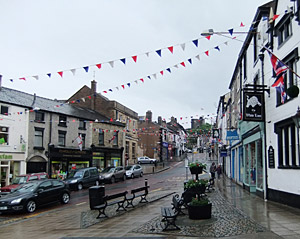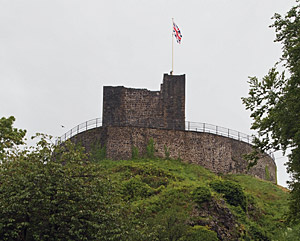Clitheroe
An ancient market town in the Ribble Valley, with the ruins of Norman castle, set high on a rocky outcrop overlooking the town.

Clitheroe Main Street © TAB
One of the oldest boroughs in Lancashire it gained its market charter in 1147. The town has a pleasant country atmosphere and retains much of its ancient character, with rows of somber, limestone buildings and white-fronted Georgian houses. The Town Hall displays the sculpted arms of the de Lacys (the Lords of Lancaster).
During the industrial revolution, Clitheroe was an important industrial centre, based on cotton milling and limestone quarrying. The old Bellmanpark Lime kiln is now a Scheduled Ancient Monument and several of the remaining cotton mills have been converted for modern usage. Today the town serves as a market centre for the wider rural area and has a variety of light manufacturing industries and a cement works.

Clitheroe Castle and Keep
The 12th-c castle, set high on its limestone crag, is a dominant landmark in the town. It was the ancient stronghold of the de Lacys, and witnessed bitter fighting during the Civil War, which brought about its final demise in 1649. Little remains today except for a small Norman keep. The last resident here was Henry, Earl of Lincoln, who died in 1311.
The battlements provide superb views over the Ribble Valley. Much of the grounds surrounding the monument are now a War Memorial park and recreational area.
The Castle Museum, just below the Keep, contains reconstructions of historic local trades and details of ancient lead mining. It also includes an important collection of fossils from the surrounding district.
The town's Royal Grammar School was founded in 1554, rebuilt on the site of a much earlier educational establishment. One notable headmaster was the Rev. T. Wilson, who compiled the first Archaeological Dictionary in the 18th-c.
The church of St Mary Magdalene's was rebuilt in 19th-c, on a site where a church has stood for nearly one thousand years. Its twisted spire was added later.
Clitheroe lies just south of the Forest of Bowland in the Ribble Valley, with delightful riverside walks. Traces of a Roman road from Ribchester to York can be found nearby.
Pendle Hill, to the east of Clitheroe, is associated with the notorious trial of several local women who were accused of being witches and executed accordingly. To the northeast lies the 13th-c Sawley Abbey, founded by the Cistercian fellows of Fountains Abbey.
Map of Clitheroe
North West England

